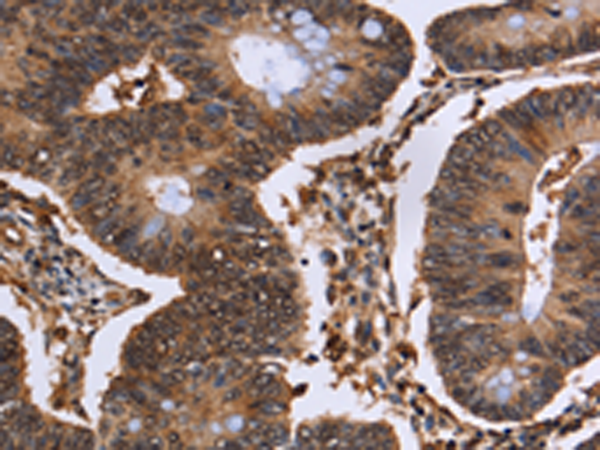

| WB | 咨询技术 | Human,Mouse,Rat |
| IF | 咨询技术 | Human,Mouse,Rat |
| IHC | 1/100-1/300 | Human,Mouse,Rat |
| ICC | 技术咨询 | Human,Mouse,Rat |
| FCM | 咨询技术 | Human,Mouse,Rat |
| Elisa | 1/2000-1/10000 | Human,Mouse,Rat |
| Aliases | RPR; BOTV; REGR; EXTR1; EXTL1L |
| Host/Isotype | Rabbit IgG |
| Antibody Type | Primary antibody |
| Storage | Store at 4°C short term. Aliquot and store at -20°C long term. Avoid freeze/thaw cycles. |
| Species Reactivity | Human, Mouse |
| Immunogen | Fusion protein of human EXTL3 |
| Formulation | Purified antibody in PBS with 0.05% sodium azide and 50% glycerol. |
+ +
以下是关于EXTL3抗体的示例参考文献(内容为模拟示例,建议通过PubMed或学术数据库获取真实文献):
---
1. **文献名称**: *EXTL3 modulates hepatocellular carcinoma progression via Wnt/β-catenin signaling*
**作者**: Li X, et al.
**摘要**: 本研究通过免疫组化(使用EXTL3特异性抗体)发现EXTL3在肝癌组织中高表达,并调控Wnt/β-catenin通路促进肿瘤侵袭,提示其作为潜在治疗靶点。
2. **文献名称**: *Genetic ablation of EXTL3 alters heparan sulfate structure and impairs angiogenesis*
**作者**: Smith J, et al.
**摘要**: 利用EXTL3敲除小鼠模型及抗体检测技术,证明EXTL3缺失导致硫酸乙酰肝素合成异常,影响血管生成和胚胎发育。
3. **文献名称**: *EXTL3 as a biomarker for glioblastoma immune microenvironment*
**作者**: Wang Y, et al.
**摘要**: 通过流式细胞术和Western blot(使用抗EXTL3抗体),发现EXTL3表达与胶质母细胞瘤免疫抑制微环境相关,可能影响患者预后。
4. **文献名称**: *Development of a monoclonal antibody targeting EXTL3 for therapeutic applications*
**作者**: Tanaka K, et al.
**摘要**: 报道了一种新型抗EXTL3单克隆抗体的开发与验证,证明其在体外可抑制肿瘤细胞迁移,并增强化疗药物敏感性。
---
**注意**:以上内容为模拟示例,实际文献需通过学术数据库(如PubMed、Web of Science)检索关键词“EXTL3 antibody”或“EXTL3 function”获取。
The EXTL3 antibody targets the EXTL3 protein, a member of the EXT-like (EXTL) gene family, which includes tumor suppressors involved in heparan sulfate proteoglycan (HSPG) biosynthesis. EXTL3. also known as EXTR1 or KIAA0510. encodes a glycosyltransferase critical for chain elongation during HSPG synthesis. HSPGs are essential components of the extracellular matrix and cell surfaces, regulating cell signaling, adhesion, and proliferation. EXTL3 catalyzes the addition of glucuronic acid and N-acetylglucosamine residues to the growing heparan sulfate chain, a process vital for maintaining tissue homeostasis and developmental signaling pathways like Wnt, Hedgehog, and FGF.
Structurally, EXTL3 contains an N-terminal transmembrane domain and a C-terminal glycosyltransferase module. Mutations or dysregulation of EXTL3 are linked to hereditary multiple exostoses (HME), a skeletal disorder characterized by benign bone tumors, and have been implicated in cancers such as leukemia and hepatocellular carcinoma. Antibodies against EXTL3 are widely used in research to study its expression, localization, and functional roles in normal physiology and disease. They enable techniques like Western blotting, immunohistochemistry, and co-immunoprecipitation, aiding in the exploration of EXTL3’s interaction networks and mechanistic contributions to pathologies. Such antibodies are crucial tools for validating EXTL3 as a potential therapeutic target or biomarker in oncology and genetic disorders.
×